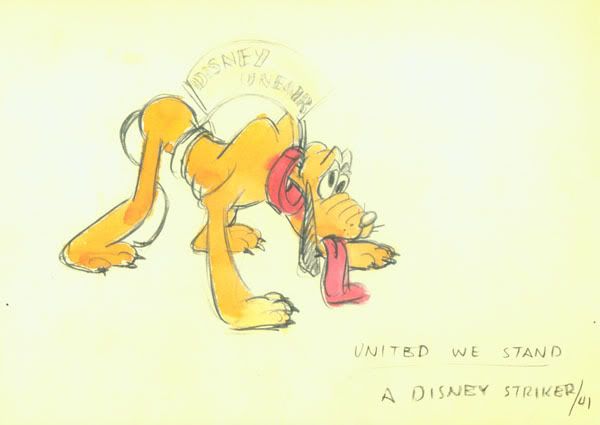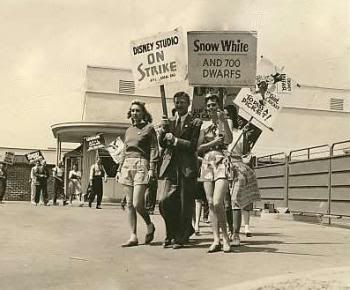
Click thumbnail for a full view. See also the bottom of this post.
... sixty-seven years ago this day.
At this point in the year 1941, the Disney Strike was half over. It started on May 29, and ended on July 29 (assuming my sources are right ... and I'm aware the link says "five weeks," but anyway ...)
TAG Prez Emeritus Tom Sito points out some of the ramifications of the two months Disney employees were out picketing on Buena Vista Street in Burbank:
No single incident had a greater impact upon the history of Hollywood animation than the Great Walt Disney Cartoonists Strike of 1941. The Disney Strike spawned new studios, new creative styles, new characters and changed animation forever. To the people who were there, it was a defining moment in their careers. New friendships were cemented and old ones broken. Many carried their anger for the rest of their lives ...
Consider this, if the strike had never happened, the UPA studio and its influence upon world animation would not have occurred, since the company was formed primarily by ex-Disney unionists. Chuck Jones' Roadrunner, Coyote and What's Opera Doc shorts would not have had their unique design style, because their art director, Maurice Noble, was a Disney art director who quit because of the strike. John Hubley never would have gone to New York, met Faith Elliot and did his award-winning independent films. Bill Melendez, the director of A Charlie Brown Christmas, was then a Disney assistant [who left the studios and never returned]. Frank Tashlin, the Looney Tunes director and future creator of the Dean Martin-Jerry Lewis live-action comedies, was in the Disney story department. A union vp, he joined the Mouse House to help unionize the cartoonists there.
Kind of like It's a Wonderful Life. If X hadn't happened, then Y wouldn't have happened. And so forth and so on.
Economically, the Disney strike changed the landscape. After unionization, Disney employees who had been at the bottom of the ladder, wage wise, saw their weekly paychecks double. Slowly, steadily, the 'toon industry became one where everyone, not just the top tier, could make enough to build homes and support families.

And Disney, despite the wage hikes, survived and prospered. Within a year of the strike the studio was jammed to the rafters with government contracts (the kind we know so well from contractors in Iraq: "cost plus") helping to win the war against Hitler and Hirohito. A decade after that there was the first of a string of highly successful amusement parks, and today there is a multi-national conglomerate that spans the globe.
The union thing worked out okay. Not perfectly, but okay.




14 comments:
Other than Bill Melendez (who turns 92 this year) how many of the Disney strikers are still around?
Former President Sito might be the best one to answer "Who survives?"
I'm guessing a few from ink-and-paint, and maybe some very young in-betweeners of the time. But I have no names.
steve - thx for the great history lesson.
if you get a chance, everyone should see the documentary about lew wasserman of MCA/Universal. while watching, it struck me that those days in hollywood benefited from ground-up people like lew and his relationships. seems like labor/management today are so far apart and come from completely different worlds, with no one to bridge the gap. hence, no one talks the same language.
Besides Bill Melendez, Bill Littlejohn and Martha Sigall are still around, all in their 90s. I can't recall any more.
Steve, I've been curious about the third-party arbitration that is used to resolve issues between the union and the studios. Generally, I've heard that arbitration favors business/management over consumers and the public. What has your experience been? Is third-party arbitration truly fair and impartial, or are there processes that favor the studios?
"if you get a chance, everyone should see the documentary about lew wasserman "
Just read the book "The Last Mogul" and learn exactly how "ground up" Wasserman was. One of the best books on Hollywood.
I've heard that arbitration favors business/management over consumers and the public. What has your experience been? Is third-party arbitration truly fair and impartial, or are there processes that favor the studios?
The thing about arbitration, we've won a few we thought we'd lose, and lost some I thought were winners.
At this stage of my illustrious career, I can pretty well sniff out which arbitrations we'll most likely win, which ones lose.
As to arbitrations being stacked in favor of companies, I think individuals with individual grievances get a reasonably fair shake.
But I don't feel that way about larger collective grievances. We had a big one several years ago, a technological change grievance against Disney were we sought displacement pay for a couple hundred employees.
We lost that one at the same time the WGAw also lost a big grievance against the studios. Both TAG and the WGAw used the same arbitrator, who ruled against both guilds.
Maybe we deserved to lose it, maybe we didn't. But a few weeks after the ruling, I had lunch with a lawyer from Warners who said to me:
"You know, the studios have never lost a big union grievance involving large numbers of employees. In sixty years, it's never happened.
"No arbitrator wants to rule against the conglomerates on a major girevance. They know they'll never arbitrate for the movie industry again. So they play it safe ..."
Now, I'm not a student of the history of labor-management litigation in the entertainment industry, so I don't know if the lawyer was 100% correct. But I think he was mostly correct.
You can deduce whether the deck is stacked against unions or not. And you don't have to be Sherlock Holmes to do it.
Thanks, Tom!!!
*Consider this, if the strike had never happened, the UPA studio and its influence upon world animation would not have occurred,*
Small loss.
*Bill Melendez, the director of A Charlie Brown Christmas, was then a Disney assistant [who left the studios and never returned].*
And we would never have seen a crummy animator turn Schulz' whimsical characters turned into ugly little gargoyles.
* Frank Tashlin, the Looney Tunes director and future creator of the Dean Martin-Jerry Lewis live-action comedies, was in the Disney story department. A union vp, he joined the Mouse House to help unionize the cartoonists there.*
A world without Martin and Lewis. The mind boggles....
Or "Will Success Spoil Rock Hunter?" Or Walt Kelly doing "Pogo".
Or a hundred other things you'd probably sneer at.
But forget all that, Oh Sour One. Focus on how the Little People began making a livable wage.
Then you can tell us how you could give a shit about that, too. I tingle with anticipation.
I have been aware of the strike, but I have not been aware of its impact it had on the world of American animation. So explaining people, like Maurice Noble leaving Disney to work on numerous Chuck Jones shorts, has made me aware of the impact this strike has had on animation history.
It maybe interesting to note the legacy of the last major strike in American entertainment (I think that was the recent Writers strike) and note what some people did before and what they are doing now.
"And we would never have seen a crummy animator turn Schulz' whimsical characters turned into ugly little gargoyles."
What?!??!
Sometime the idiocy in here is downright depressing. dude, get a clue.
Speaking as someone who has directed a lot of TV animation, I always considered Melendez's A CHARLIE BROWN CHRISTMAS and Abe Levitow's MAGOO'S CHRISTMAS CAROL as the two best bits of animation ever done for TV.
The first section of the kids ice-skating on that downshot was animated by Bill M himself, straight ahead, all on one level. I'd like to see someone do that again!
Magoo's Xmas Carol is the best animated version bar none. Great music and good storytelling! Only goof up is having the spirits arrive out of order.
Post a Comment